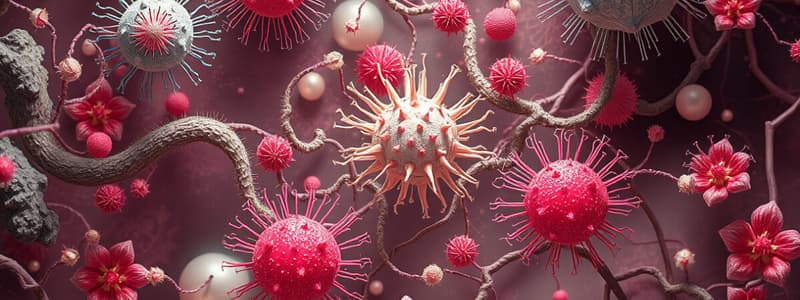Podcast
Questions and Answers
What distinguishes resident microorganisms from transient microorganisms on the skin?
What distinguishes resident microorganisms from transient microorganisms on the skin?
- Resident microorganisms survive without causing harm and are difficult to remove. (correct)
- Resident microorganisms are more pathogenic than transient microorganisms.
- Transient microorganisms are native to the skin and multiply in deep layers.
- Transient microorganisms are permanent residents of the skin.
Which factor does NOT contribute to the potential of microorganisms to cause disease?
Which factor does NOT contribute to the potential of microorganisms to cause disease?
- The ability to enter and survive in the host.
- Virulence, or the ability to produce disease.
- The presence of antimicrobial soaps. (correct)
- A sufficient number of organisms.
How can transient microorganisms be effectively removed from the skin?
How can transient microorganisms be effectively removed from the skin?
- By applying physical pressure to the skin.
- Through hand hygiene practices such as proper handwashing. (correct)
- With the natural oils produced by the skin.
- By using antimicrobial agents regularly.
Which of the following is a characteristic of Staphylococcus aureus?
Which of the following is a characteristic of Staphylococcus aureus?
Which microorganism is an example of a transient bacterium typically found on the skin?
Which microorganism is an example of a transient bacterium typically found on the skin?
Flashcards are hidden until you start studying
Study Notes
Types of Microorganisms
- Microorganisms include bacteria, viruses, fungi, and protozoa.
- Skin microorganisms are classified into resident and transient flora.
Resident Microorganisms
- Permanent residents of the skin that survive and multiply without causing harm.
- Difficult to remove through regular hand-washing unless significant friction is applied.
- Deep skin layers require antimicrobial products for effective removal.
- Staphylococcus aureus is a common resident microorganism of the skin.
Transient Microorganisms
- Temporary organisms that adhere to the skin after contact with people or objects.
- Example of contact leading to transient microorganisms: touching a bedpan or contaminated dressing.
- These organisms are loosely attached and can easily be transmitted if not properly removed.
- Escherichia coli (E. coli), typically found in the bowel, is an example of a transient bacterium affecting the skin.
Factors Influencing Disease Potential
- Sufficient quantity of microorganisms is necessary for disease.
- Virulence: The organism's ability to cause disease.
- Organism's capacity to enter and survive within the host.
- Susceptibility of the host plays a critical role in infection risk.
Studying That Suits You
Use AI to generate personalized quizzes and flashcards to suit your learning preferences.




